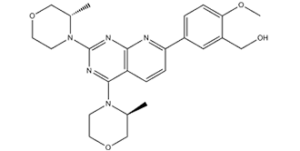AZD8055
This product is for research use only, not for human use. We do not sell to patients.

For small sizes, please check our retail website as below: www.invivochem.com
| Size | Price | Stock |
|---|---|---|
| 500mg | $470 | Check With Us |
| 1g | $700 | Check With Us |
| 5g | $1770 | Check With Us |
Cat #: V0177 CAS #: 1009298-09-2 Purity ≥ 98%
Description: AZD8055 is a novel, potent selective, and orally bioavailable ATP-competitive mTOR (mammalian target of rapamycin) inhibitor with potential anticancer activity.
Top Publications Citing Invivochem Products
Publications Citing InvivoChem Products
Product Promise

- Physicochemical and Storage Information
- Protocol
- Related Biological Data
- Stock Solution Preparation
- Quality Control Documentation
| Molecular Weight (MW) | 465.54 |
|---|---|
| Molecular Formula | C25H31N5O4 |
| CAS No. | 1009298-09-2 |
| Storage | -20℃ for 3 years in powder formr |
| -80℃ for 2 years in solvent | |
| Solubility In Vitro | DMSO: 50 mg/mL (107.4 mM)r |
| Water: <1 mg/mLr | |
| Ethanol: 3 mg/mL (6.4 mM) | |
| Solubility In Vivo | 4% DMSO+30% PEG 300+ddH2O: 5 mg/mL |
| SMILES Code | OCC1=CC(C2=NC3=NC(N4[C@@H](C)COCC4)=NC(N5[C@@H](C)COCC5)=C3C=C2)=CC=C1OC |
| Synonyms | AZD8055; AZD-8055; AZD 8055 |
| Protocol | In Vitro | The inhibitory activity of AZD-8055 (AZD8055) against mTOR is evaluated using two different assays. Using the truncated recombinant mTOR enzyme, the IC50 for AZD8055 is 0.13±0.05 nM. Using native mTOR enzyme complexes extracted from HeLa cells, the IC50 is 0.8±0.2 nM. AZD-8055 shows excellent selectivity (~1,000-fold) against all class I PI3K isoforms and other members of the PI3K-like kinase family. AZD-8055 inhibits the phosphorylation of mTORC1 substrates p70S6K and 4E-BP1 as well as phosphorylation of the mTORC2 substrate AKT and downstream proteins. The cellular IC50s for AZD8055 are calculated as 24±9 nM (n=13) for pAKT Ser473 and 27±3 nM (n=12) for pS6 Ser235/236 in MDA-MB-468 cells. |
|---|---|---|
| In Vivo | In mice bearing U87-MG (PTEN null) glioblastoma xenografts, oral treatment with AZD-8055 (AZD8055) results in a dose-dependent tumor growth inhibition of 33%, 48%, and 77% with 2.5, 5, and 10 mg/kg/d twice daily, respectively. A similar dose dependency is observed in nude mice bearing A549 xenografts: tumor growth inhibition is 44%, 55%, and 93% after 2.5, 5, and 10 mg/kg/d twice daily, respectively. AZD8055 also results in significant inhibition of tumor growth and/or regression in breast, lung, colon, prostate, and uterine xenograft models when administered either twice daily at 10 mg/kg or daily at a dose of 20 mg/kg. |
These protocols are for reference only. InvivoChem does not
independently validate these methods.
| Solvent volume to be added | Mass (the weight of a compound) | |||
|---|---|---|---|---|
| Mother liquor concentration | 1mg | 5mg | 10mg | 20mg |
| 1mM | 2.1480 mL | 10.7402 mL | 21.4804 mL | 42.9609 mL |
| 5mM | 0.4296 mL | 2.1480 mL | 4.2961 mL | 8.5922 mL |
| 10mM | 0.2148 mL | 1.0740 mL | 2.1480 mL | 4.2961 mL |
| 20mM | 0.1074 mL | 0.5370 mL | 1.0740 mL | 2.1480 mL |
The molarity calculator equation
Mass(g) = Concentration(mol/L) × Volume(L) × Molecular Weight(g/mol)
Mass
=
Concentration
×
Volume
×
Molecular Weight*
The dilution calculator equation
Concentration(start)
×
Volume(start)
=
Concentration(final)
×
Volume(final)
This equation is commonly abbreviated as: C1 V1 = C2 V2
Concentration(start)
C1
×
Volume(start)
V1
=
Concentration(final)
C2
×
Volume(final)
V2
Step One: Enter information below
Dosage mg/kg
Average weight of animals g
Dosing volume per animal µL
Number of animals
Step Two: Enter the in vivo formulation
%DMSO
+
%
+
%Tween 80
+
%ddH2O
Calculation Results:
Working concentration:
mg/ml;
Method for preparing DMSO master liquid:
mg
drug pre-dissolved in
µL
DMSO(Master liquid concentration
mg/mL)
,Please contact us first if the concentration exceeds the DMSO solubility of the batch of drug.
Method for preparing in vivo formulation:
Take
µL
DMSO master liquid, next add
µL
PEG300, mix and clarify, next add
µL
Tween 80,mix and clarify, next add
µL
ddH2O,mix and clarify.
Note:
- (1) Please be sure that the solution is clear before the addition of next solvent. Dissolution methods like vortex, ultrasound or warming and heat may be used to aid dissolving.
- (2) Be sure to add the solvent(s) in order.




































